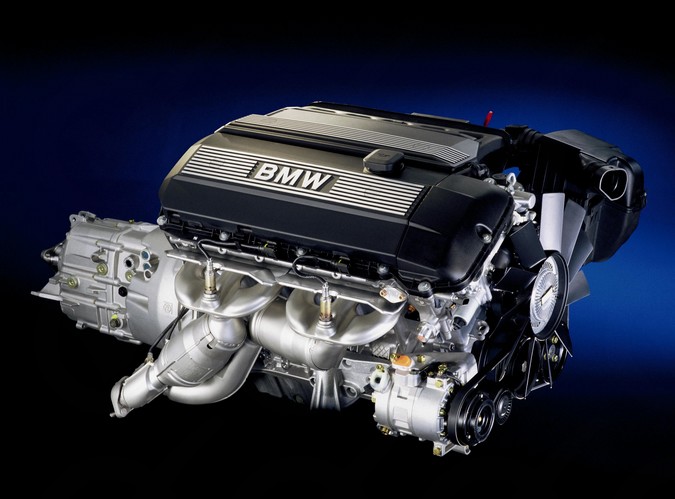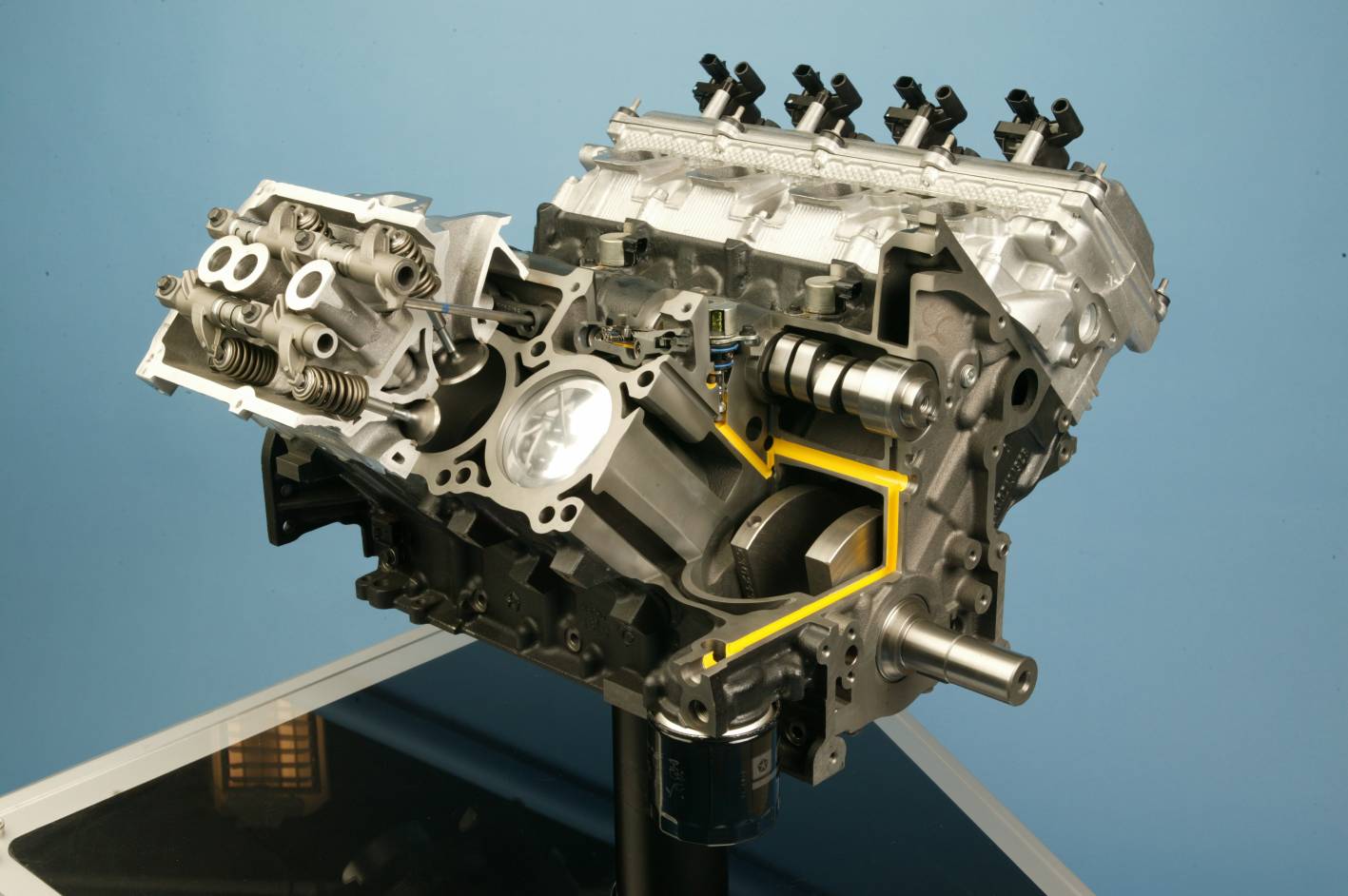M52 engine
Based on the M50TU, the M52 engine had an aluminium-alloy crankcase with a closed-deck design, Nikasil cylinder liners, double overhead camshafts, four valves per cylinder, variable intake camshaft timing (BMW’s VANOS) and a maximum engine speed of 6500rpm.
Compared to the M50TU, changes for the M52 included:
- An aluminium-alloy block for a 20 kg mass reduction;
- The introduction of Siemens engine management with OBDII compliance;
- Lighter connecting rods and pistons (the latter with thinner rings);
- Conical valve springs and shorter lifters for reduced friction;
- Additional material cast between the camshaft lobes to improve balance and smoothness at low engine speeds;
- A small-bore inlet manifold which had a lower flow rate than the M50 and M50TU manifolds. It is believed that BMW limited the intake manifold flow to reduce peak power output for more favourable taxation treatment. As a result, a common modification is to swap the M52 intake manifold with that from the M50/M50TU engine; and,
- Stainless steel exhaust manifolds (previously cast iron).
Within the M52 engine family, the M52B20 and M52B25 engines had a cast iron crankshafts; the M52B28 engine, however, had a forged steel crankshaft and graphite-coated pistons to reduce friction.
For North American models, and with the exception of the Z3, the M52 engine had a cast iron block.
M52TU
Available from 1998, the M52TU engine was the first series production BMW engine to feature ‘double VANOS’ which could advance or retard timing of both the inlet and exhaust camshafts. The M52TU engine also introduced electronic throttle control.
Its name notwithstanding, the M52TU engine was practically a new engine as it had:
- A new aluminium alloy block and cylinder head. The block and cylinder head had new cooling passages whereby coolant would initially flow from the water pump to the cylinder head (rather than the block). Coolant volume within the block was also reduced to increase engine block temperatures and improve combustion efficiency;
- A new variable length intake manifold;
- A new exhaust manifold with integrated ‘near engine’ catalytic converters; and,
- Introduced an electronically-controlled thermostat.
Components carried over from the M52 engine included the crankshafts, connecting rods, pistons, camshaft carries, valves, valve springs and lifters.
| Engine | Capacity | Peak power | Peak torque | C.R. | Models | Years |
|---|---|---|---|---|---|---|
| M52B20 | 1991 cc (66.0 x 80.0) |
110kW at 5900rpm | 190Nm at 4200rpm | 11.0:1 | E36 320i | 1994-99 |
| E39 520i | 1996-99 | |||||
| M52TUB20 | 1991 cc (66.0 x 80.0) |
110kW at 5900rpm | 190Nm at 3500rpm | 11.0:1 | E46 320i, E46 320Ci |
1998-00 |
| E39 520i | 1998-00 | |||||
| E36/7 Z3 2.0i | 1998-00 | |||||
| M52B25 | 2494 cc (75.0 x 84.0) |
125kW at 5500rpm | 245Nm at 3950rpm | 10.5:1 | E36 323i | 1994-99 |
| E36 323ti | 1997-00 | |||||
| E39 523i | 1995-98 | |||||
| M52TUB25 | 2494 cc (75.0 x 84.0) |
125kW at 5500rpm | 245Nm at 3500rpm | 10.5:1 | E46 323i, E46 323Ci |
1998-00 |
| E39 523i | 1998-00 | |||||
| M52B28 | 2793 cc (84.0 x 84.0) |
142kW at 5300rpm | 280Nm at 3950rpm | 10.2:1 | E36 328i | 1994-99 |
| E39 528i | 1995-98 | |||||
| E38 728i, E38 728iL |
1996-98 | |||||
| E36/7 Z3 2.8i | 1997-99 | |||||
| M52TUB28 | 2793 cc (84.0 x 84.0) |
142kW at 5500rpm | 280Nm at 3500rpm | 10.2:1 | E46 328i, E46 328Ci |
1998-00 |
| E39 528i | 1998-00 | |||||
| E38 728i, E38 728iL |
1998-01 | |||||
| E36/7 Z3 2.8i | 1998-01 | |||||
| S52B32 | 3152 cc (89.6 x 86.4) |
179kW at 6000rpm | 320Nm at 3800rpm | 10.5:1 | E36 M3 (USA) | 1995 |
BMW M52 engine problems
M52 and M52TU VANOS failure
For the M52 and M52TU engines, the VANOS units may fail due to deterioration of the VANOS piston seal O-ring which is made from Buna (a material with limited temperature resistance). Over time, the O-ring hardens and shrinks, causing it to lose its functional characteristics – this can cause symptoms such as a loss of power below 3000 rpm, surging around 3000 rpm, a louder idle and rough running, and rough running.
The piston O-ring lies under and provides support to a Teflon piston seal ring. Replacing the O-ring requires the Teflon seal to be removed for access. Since the Teflon seal cannot be removed from the piston seal groove without damaging it, the Teflon and O-ring seals must be replaced simultaneously. For greater longevity, the Buna O-ring can be replaced with an O-ring made from Viton.
For the M52TU engine, the VANOS units had two piston seals with O-rings, while each piston had two O-ring sizes to provide hydraulic sealing in two VANOS cylinders of different sizes and an additional, smaller O-ring that was used to seal off a piston bearing. It is understood that the O-ring for this cap was also made from Buna and deteriorated in the same manner as the piston seal O-rings.
M52 and M52TU VANOS rattle
VANOS rattle generally occurs from 1800 to 2200 rpm, but may also occur at idle. The rattle is caused by wear in the variable valve timing helical (slanted) gears which are found on the camshaft, camshaft sprocket and splined shaft which attaches to the VANOS unit. Wear of the helical gear allows the camshaft to have lash movements that engage the splined shaft axially; the axial play that causes the rattle is found on the helical gears and the splined shaft bearing.
Removing the splined shaft bearing axial play significantly reduces the VANOS rattle. The splined shaft bearing is made of a thick washer and two thrust (roller) bearings. The washer and two thrust bearings are encased in a ring and two outer flat washers; the complete bearing is housed inside a splined shaft cavity that is closed with a threaded cover.
Since the thrust bearings and centre washer have tight tolerances, they cannot be replaced. To fix, a replacement VANOS piston bearing ring is manufactured to the same specification as the original bearing ring but with a shorter height (manufactured to a tight height tolerance). The bearing ring is a difficult and expensive component to manufacture since it is made from a special bearing steel, hardened and its surfaces ground. For further information, see http://www.beisansystems.com/procedures/single_vanos_rattle_procedure.htm and http://www.beisansystems.com/procedures/double_vanos_rattle_procedure.htm.










